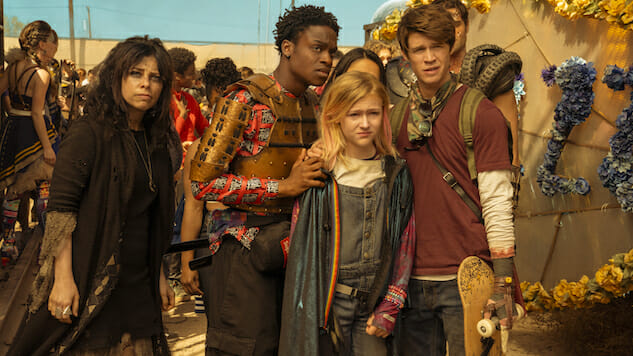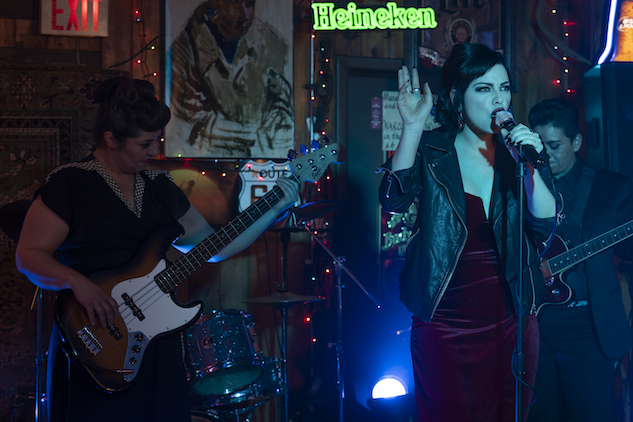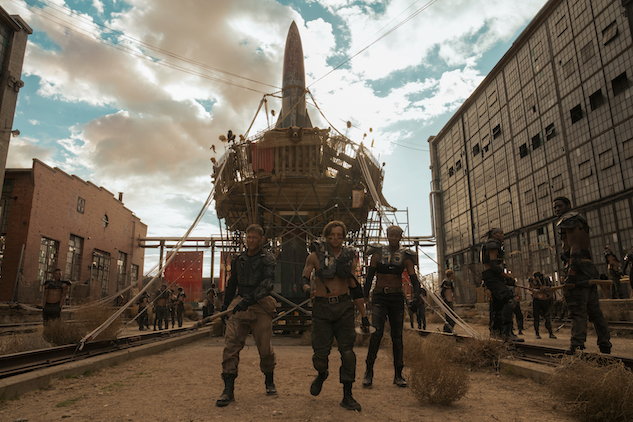Why Daybreak Might Be Netflix’s Cleverest Original Series to Date
Yes, this post-apocalyptic teen dramedy proves Netflix has innovated a new subgenre of TV as an artistic medium.
Photo Courtesy of Netflix
It is the freakishly rare show that can cut from the brain-searing visual gag of a giant mutant pug humping a crazed bully to death (terrible, hate it) straight to a surprise eleventh-hour bonding scene so moving it draws genuine tears (legend, love it), but in case you missed the memo, the burnt-sienna wasteland of a teen apocalypse comedy joint that is Netflix’s allusion-happy Daybreak has been, from the very beginning, all about being that freak.
Of course, when it was time for the first round of reviews to be filed, critics—who had only been given the first five episodes to screen in advance of the series’ late-October premiere—had no way of knowing how the Daybreak team’s big, freaky swing to the bombed-out fences would land. With POV shifts that dragged the audience’s focus from white hero-type Josh (Colin Ford, breaking the fourth wall Ferris Bueller-style) to morally flexible kid genius Angelica (Alyvia Alyn Lind, channeling The Godfather) to gay, black ex-jock Wes (Austin Crute, whose kung fu-animated journey is narrated, deliberately and delightfully, by RZA), there was enough potential creative energy on the ambitiously gross series’ side to mostly earn it warmer-than-middling praise. In a television landscape overrun both by zombies and by pretentiously subversive takes on teen tropes that don’t ultimately add much to a long and rich teen television tradition, finding the critical appetite to watch enough of Daybreak to see if that gross ambition paid out enough to shoot the show past warmer-than-middling was always going to be a big ask. But in this case, watching the whole season was the only way to understand any of it.

Despite the fact that I generally can’t stomach any kind of zombie-adjacent viscerality on my screen—and the related fact that, specifically, the visual of Ms. Crumble (Krysta Rodriguez) unhinging her too-toothy jaw to give Josh space to fish around her insides for a swallowed key early in the season gave me a week of nightmares—there was something about Daybreak that drew me back in, even as screeners for other shows I had to review kept piling up. Maybe it was the narrative cleverness of the silent disco in the mall at the end of the last episode we’d been given to screen (“Homecoming Redux or My So Called Stunt Double Life”); maybe it was the surprise tenderness brought to the proceedings by late-blooming secondary characters like Eli (Gregory Kasyan) and KJ (Chelsea Zhang); maybe it was the can’t stop, won’t stop glee promised by the snicker-inducing title (ahem: “5318008”) of the next episode in the queue. Maybe it was the fact that watching Ms. Crumble find ever more joints to squelchily unhinge was still less unsettling than spending another 45 minutes on IRL Twitter. Maybe it was all of the above.
![]()
Once I capitulated to giving Daybreak the second look it seemed to deserve, though, each new confidently bonkers creative decision gave me another reason to keep going. And in the end, it all added up. First there was that notorious “5318008,” which opened with Turbo Bro Jock’s (Cody Kearsley) wordless, psychotically meticulous action figure recreation of their loss at the Battle at the Mall, before cutting to him giving a roaring grunt of a speech to his jock followers whose fucking wild subtext scrolled up the screen like some kind of Star Wars pre-reel on Adderall. After wearing out my pause button trying to catch every detail of that, there was the entirety of Episode 7, “Canta tu vida,” which finds the witch-ghoulie Crumble using a classic, fullscreen sitcom format (directed, naturally, by Angelica) to trawl her broken brain for answers about what happened to her before the blast, and why it’s important for her to embrace whatever it is she’s become. In one of these sitcom scenes, she eats a brain straight from a student’s skull. In another, she fronts a killer all-Latina Morrissey cover band while wearing a wine-red velvet dress and black leather jacket. In another, she turns straight to the camera and reminds us that being a woman doesn’t mean not being imperfect or a trainwreck or a monster, but rather, that those are all the things that make us (and her) human. And then she eats a handful of maggots. Because, sure, why not!

This teacherly digression leads into Angelica and Crumble’s deadly serious slapstick introduction to the Cheermazons, whose Power Trio leadership comprises a foursome of diverse bad bitches that includes two Cheermazons of color (one a hijabi Muslim) plus a deaf Cheermazon and her interpreter. That narrative journey leads into the suspiciously long-awaited return of Sam Dean (Sophie Simnett), as anchored by a half sweet, half monstrously uncomfortable flashback episode told from her flowery, principal-palling POV, which in turn bleeds into the dual childhood flashback episode that bonds child-of-divorce Josh and child-of-immigrants Eli just in time to [SUPER SPOILER] make Eli’s sudden, accidental death the very first in the long, murder-happy season to draw real tears. And all of this is just the lead-up to a pro-vax agenda (!) realization that makes the parameters of Daybreak’s “only teens survived” bio-bomb apocalypse make sense, a season finale that unfolds almost entirely as a silent film (complete with Love, Actually callbacks and a surprise reveal of Josh’s latent ASL skills), two last-minute plot twists that break open exquisitely surprising new paths for the story to follow in its inevitable second season, and Netflix’s first fictional, in-universe Spotify podcast, The Only Podcast Left. (Currently on its IRL rollicking third episode.)
-

-

-

-

-

-

-

-

-

-

-

-

-

-

-

-

-

-

-

-

-

-

-

-

-

-

-

-

-

-

-

-

-

-

-

-

-

-

-

-









































